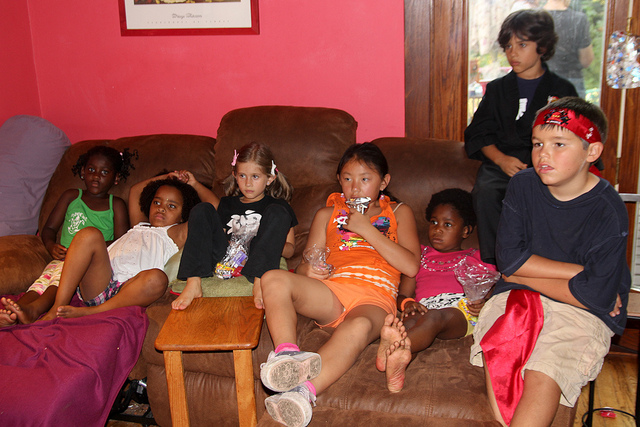When it comes to modern day parenting, screen time is the enduring buzzword. And while we can justify much of the 9 hours on average that today’s kids spend in front of screens, TV continues to be seen by many as the mental junk food of the digital age. This line of reasoning isn’t wrong. Kids’ lives are so filled with technology that it’s only right for parents to feel they need to draw a line in the sand somewhere. And it’s only logical that TV would be the odd thing out. But is TV really bad for kids?
Homework in front of a computer? Okay, that’s necessary. Video games? At least they are using their brains and building skills. Texting and social media? Well, that’s how kids communicate these days. But where’s the value in television?
Don’t worry. I’m not here to TV shame you. If you’re like many parents, cutting TV out of the equation just doesn’t work. It’s one of those screen time activities that frees you up to pay bills, check email, make dinner, or just shower in peace. And that’s okay, really. More than okay.
Because beyond the free time it affords you, TV isn’t really all that bad for kids. In moderation, it can be a useful tool — instructional, inspirational, and perspective-giving. In fact, kids with ADHD and ASD in particular may get quite a lot out of watching television. Especially beneficial is the interactive style of educational television we see with programs like Sesame Street, Peg + Cat, and Creative Galaxy. And if you watch with your kids, it can even be a way to learn more about them.
The key is deciding what, how much, and why your kids are watching. If you’re just looking to take a quick breather away from your older children, you may be willing to settle for harmless over wholesome. Experts recommend that a child under two, however, should be consuming only high-quality programming for no more than an hour a day. We suggest that you check out the American Academy of Pediatrics (AAP) guidelines for screen time to decide what’s right for your family.
These rules relax to a certain degree when TV time becomes family time. Besides the fact that you’re there monitoring the appropriateness of a program for your children, watching TV with your kids can present countless opportunities to have conversations about educational concepts, art and music, other cultures, different points of view, and anything you or your kids find new and exciting. When you watch and talk about a television show with your kids — phones and other devices down — you’re not only spending time together, you’re removing one of the characteristics of television that make it so problematic to experts. The discussions you have and the questions you ask each other about what’s going on in the show convert the act of watching television from passive entertainment to active consumption.
It’s also important to consider representation in media. It can be difficult to find good role models on TV, and even more difficult to find role models that represent and celebrate our differences. Julia, the Sesame Street muppet on the autism spectrum, and Doc McStuffins, the girl who doctors broken toys, are examples of diversity in television that are really good for all children to see. The educational value lies in the perspective-taking and social awareness practice kids get from being exposed to different points of view, and it’s even better when you’re there to help them make connections.
Stuck on what to watch? This article in The Huffington Post has some good ideas for kids’ TV that parents won’t hate watching. See the Common Sense Media Essential TV Guide to make an informed decision about which shows are best for your kids to watch.
The difference between active consumption and passive consumption is precisely what makes a video game such an excellent tool for reaching and teaching kids. See “Video Games vs. Imagination: The Great Debate” to read more.
For ideas about dialing back TV and doing other things as a family, read “Three Family Resolutions That Are Totally Realistic” and “What to Do When Your Child Loves Screen Time More Than Anything.”
Featured image: Flickr user Steven Depolo




